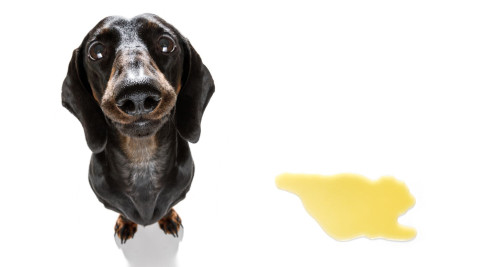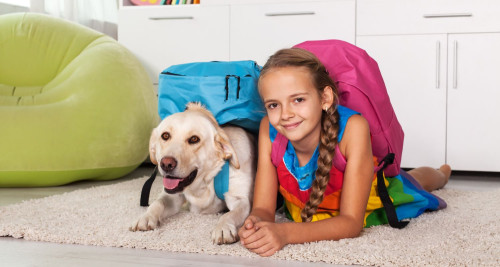The Pug

Breed Traits and Characteristics
According to the American Kennel Club, here are some breed characteristic you can find in Pugs.
- Height
10-13 inches
- Weight
14-18 pounds
- Life Expectancy
13-15 years
- Coat Type/Length
Smooth/Short
-
100 Affectionate with Family
-
100 Good with Young Children
-
80 Good with Other Dogs
-
80 Trainability Level
-
60 Energy Level
-
20 Barking Level
-
80 Shedding Level
-
20 Drooling Level
History
The Pug is often thought of as coming from Holland, but the breed in fact originated in China. It is likely the breed was first transported to Holland via trading ships around 1572.
History tells that it was a Pug’s barking which sounded the alarm to approaching Spanish soldiers in the late 1500s when Spain tried to take control of Holland. This Pug was credited with saving his master’s life - Prince William the Silent. The breed forever after has been associated with the Royal House of Orange.
Napoleon’s wife owned a Pug, and the Duke and Duchess of Windsor owned a Pug as a royal companion. The Pug became the latest rage during Victorian England, and Pugs can be spotted in many paintings and other artwork of that time.
Some believe the Pug’s name came from their likeness to a marmoset monkey, also called the ‘pug monkey,’ but the other theory is that the Pug name is derived from the Latin word ‘pugnus’ which means ‘fist’ - perhaps describing the breed’s round face and head.
The Pug
The Pug is an ancient Chinese dog breed with an impressive history, having been revered alongside royalty. The breed motto is "multum in parvo," a Latin phrase meaning a lot in a little - plenty of dog in a small package!
Pugs are members of the toy breed category and have a strong, noble appearance. The Pug is possibly one of the strongest and sturdiest dogs in this breed category. This sturdiness, along with their impressive looks, is perhaps a big reason behind their popularity.
Here's what the American Kennel Club has to say about the Pug:
"Once the mischievous companion of Chinese emperors, and later the mascot of Holland’s royal House of Orange, the small but solid Pug is today adored by his millions of fans around the world. Pugs live to love and to be loved in return."
Pug Breed Facts
Physical Characteristics
The ideal Pug tail should have two curls and stand proudly over the dog’s rump area.
Pugs have well-round heads, a short flat muzzle, and lots of wrinkles on their forehead. These vertical wrinkles on the forehead is said to resemble the Chinese character for the word "prince" and thus is known as the "prince mark."
The pug has a square body shape, a short dense double coat, and bulbous and prominent eyes that protrude. Like many of the flat-faced breeds, a Pug’s are prone to eye trauma because of their prominence.
A Pug’s coat color can range from a fawn and an apricot shade to silver and black. The black dogs are the only color to not have a darker mask.
Pug’s are strong and sturdy dogs with height generally ranging from 10 to 11 inches and weight from 14 to 18 pounds (six to eight kilograms).
Their short pushed in face and wrinkled forehead make them appear wise and they look as though they understand everything you are saying.
Their short dense, double coat makes them adaptable to most climates, but the very hot and humid days are not their friend.
Personality & Temperament
The Pug generally has a very even temperament with a somewhat sober side. They are sociable and usually get on well with other dogs. Pugs are also generally very good with children. They are more than happy to just hang out with their favorite human and often like to have their pet parents in sight.
Pugs are known to sometimes have a stubborn streak, but we believe that it’s largely due to them not always being properly understood and a lack of proper education and obedience training.
A very trainable breed, Pugs but won’t suffer fools lightly, you have to be in tune with their personality and understand what training best suits their needs.
Despite their adaptability to training, Bark Busters still get calls to train lots of Pugs or to address behavioral issues. The main issues are barking, not coming when called, dog aggression, and/or separation anxiety.
The Pug is a highly intelligent breed that adapts to training quite quickly providing their human is consistent and patient.
Fun Facts
- It is believed that Pugs are related to the larger Mastiff dog breed and have been bred down to its diminutive size over many years. They do physically resemble a Mastiff in many ways, until you get to the tail.
- Did you know that the ideal pug tail has two curls? The AKC notes that “the double curl is perfection.”
- Pugs are the sturdiest dogs of the toy family, due to their mastiff heritage.
- Pug’s do snore.
- Due to their short snout, Pug’s don’t do well in very hot or humid weather. Take caution in summer / warm months, and don’t over exercise this breed.
- Living up to 15 years of age, Pugs often enjoy a long lifespan.
- The Pug became even more popular in the U.S. following the release of “Men in Black.” The movie featured Frank, the speaking Pug who was really an alien in disguise.
Bark Busters Trainer Jeff Drier on Pugs
When I think of Pugs I think of silly clowns. These dogs are mischievous and get away with it because they are so darned cute. I have seen more than one pug dance on its hind legs, especially if there is food around. It is an adorable display which almost always makes everyone around laugh, which I almost think is the intention. Pugs LOVE attention and will often put on quiet the show in order to get it.
While with a lot of Pugs it doesn’t matter too much, usually we are called because their people have not given these dogs any rules or boundaries at all and the dog has “taken over the household” and set their own set of rules. They can be moody as well and can pout if you don’t give in. They will usually get over it quickly and are typically compliant dogs that are easy to train as they want to please and get praised.
Typical issues are barking for attention, often at meal time. Pugs love to eat and can easily become over-weight if given into. They are also typically pullers on leash until taught to walk with you and not lead. Pugs are usually friendly but can tend to jump on the people they live with and visitors which is another issue we are called to help resolve.
Be careful about rewarding with treats as often these dogs will learn to not listen is there isn’t a treat reward, as I said these dogs love to eat. They will try to take advantage of those human treat dispensers.
Caution needs to be taken, especially in the summer, as with other flat faced dogs, breathing can be problematic in the heat and humidity of summer. Walks in the summer need to be short because of their physical characteristics. They are not excessively energetic dogs but are usually willing to participate in the family activities. They also do not need a lot of space and so are often good companions for apartment dwellers. Playing inside in the air conditioning during the summer is usually enough physical exercise for Pugs.
Overall Pugs are wonderful companions, with a cheerful disposition and they are not one of the main breeds we are called to help fix problems with. As with all dogs though, if you aren’t setting rules and boundaries, they will make up their own, which may not be in line with your thoughts and feelings.
While, as I mentioned, they are not one of the dogs that we get huge numbers of calls for help with, Dogs are all individuals and so their individuality needs to be considered when working with them. Bark Busters Trainers’ unequalled experience at helping dog owners resolve problems can usually help owners of Pugs quickly, so if you do have issues with your Pug, call us today so you can get help quickly and have a long wonderful relationship with your four-legged comedian.
Connect with Us!
Need help training your Pug? Call 1-877-500-BARK (2275)or enter your zip code.
Pug Grooming
The Pug is not hard at all to keep looking its best. A quick brush daily is best, making sure not to rip out any undercoat before its due to come out and definitely not in the winter.
Once the season changes, you will need to give your Pug a regular brush. Be sure you pay special attention to the areas around the face where the folds are.
The Pug does suffer skin conditions because of the many folds around its face which need regular attention. Make sure to keep those folds clean and free of dirt and grime. Diet does play a big role in skin conditions, so be sure your Pug has all of the nutrients it needs to stay healthy and without any skin issues.
A regular visit to your vet is recommended to ensure your Pug does not develop any skin conditions.
Tips for Every Dog Owner
Hear from Bark Busters Clients Who Have a Pug
Stop the Struggle, Start the Bond: Fill Out Our Form to Unlock Your Pug's Potential!
Submit your zip code and complete the quick form. We’ll connect within 24 hours to talk through your dog’s training options. Ditch the hassle of group classes—opt for focused, in-home guidance.
- 99.7% 4 or 5 stars 99.7% rate their experience with Bark Busters as 4 or 5 out of 5 stars.
- 99.6% Would Recommend 99.6% would recommend Bark Busters to their friends and neighbors.
- 99.5% Dog Responded 99.5% think their dog responded well to the training.
Need Dog Training Assistance with Your Pug? Find Your Local Trainer Now!
CALL TODAY 1-877-500-BARK (2275)








